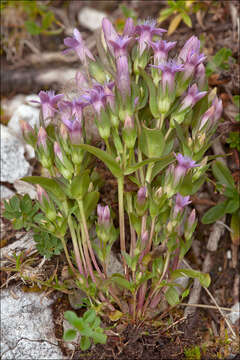Gentianella-anisodonta-ssp-calycina_33

Description:
Gentianella anisodonta (Borbas) Lve & Lve ssp. calycina (Koch) Lve & Lve, syn.: Gentiana obtusifolia Willd. var. calycina Koch, Gentiana anisodonta Borbas ssp. calycina (Koch) HayekDolomitian Gentian, DE.: Kelh-KranzenzianSlo.: aasti svievecDat.: Aug. 1. 2015Lat.: 46.44194 Long.: 13.63686Code: Bot_906/2015_DSC8234Picture file names: from Gentianella-anisodonta-ssp-calycina_raw_30 to Gentianella-anisodonta-ssp-calycina_raw_35.Habitat: Steep grassland, southeast aspect; skeletal, calcareous ground; open place, full sun, exposed to direct rain; average precipitations ~ 3.000 mm/year, average temperature about 0 deg C, elevation 2.030 m (6.700 feet), alpine phytogeographical region. Substratum: soil.Place: Mt. Mangart region, grass covered southeast slopes of the ridge between ez jezik pass, 2.055 m and Sedelce pass, 2.031 m, East Julian Alps, Posoje, Slovenia EC.Comment: Gentianella anisodonta ssp. calycina is a beautiful plant, which blooms late and is therefore one of last autumn joys of mountain flowers lovers. It is a plant with not yet agreed upon taxonomy. No wonder! Most species of this genus are very variable. Plants which bloom first in late spring, those, which bloom in summer and those, which bloom even later, may differ drastically in their habitus. All kinds of intermediates can be found. Some authors simply recognize only the name Gentianella anisodonta (Ref.: 3. for example), others distinguish three different taxa within this species name, either on subspecies, varieties or forms level. Nevertheless, Gentianella anisodonta ssp. calycina is considered a high mountains taxon, which doesn't change much regarding different blooming time. Shape, size, sameness and type of the edge of calyx lobes are particularly important in determination. Gentianella anisodonta ssp. calycina has papillate edges of calyx lobes (papillae can be seen on Fig.34). The papillae are about twice as long as thick. Very, very similarly looking but much rarer Gentianella pilosa differs just in a small detail. Its mid rib of calyx lobes is minutely papillate too, contrary to Gentianella anisodonta ssp. calycina. The difference can be seen only using a good hand lens. Regardless to this, both plants are very beautiful and there is fortunately only one 'kind' of beauty!Ref.:(1) M.A. Fischer, W. Adler, K. Oswald, Exkursionsflora fr sterreich, Liechtenstein und Sdtirol, LO Landesmuseen, Linz, Austria (2005), p 698.(2) A. Martini et all., Mala Flora Slovenije (Flora of Slovenia - Key) (in Slovenian), Tehnina Zaloba Slovenije (2007), p 511. (3) D. Aeschimann, K. Lauber, D.M. Moser, J.P. Theurillat, Flora Alpina, Vol. 2., Haupt (2004), p 28.
Included On The Following Pages:
- Life (creatures)
- Cellular (cellular organisms)
- Eukaryota (eukaryotes)
- Archaeplastida (plants)
- Chloroplastida (green plants)
- Streptophyta
- Embryophytes
- Tracheophyta (ferns)
- Spermatophytes (seed plants)
- Angiosperms (Dicotyledons)
- Eudicots
- Superasterids
- Asterids
- Gentianales
- Gentianaceae (gentian family)
- Gentianella (dwarf gentian)
- Gentianella anisodonta
This image is not featured in any collections.
Source Information
- license
- cc-by-nc-sa
- copyright
- Amadej Trnkoczy
- photographer
- Amadej Trnkoczy
- original
- original media file
- visit source
- partner site
- Flickr Group
- ID


